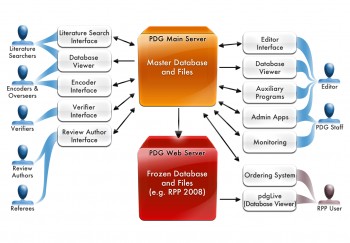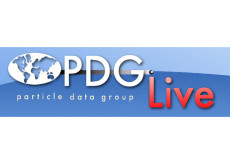Bringing The Review of Particle Physics Online
August 22, 2012
Linda Vu, lvu@lbl.gov, +1 510 495 2402
Are you interested in exotic particles, but have not gotten around to reading every particle physics journal published in the last 55 years to learn everything there is to know about them? Not to worry, the 2012 edition of The Review of Particle Physics contains everything you need to know. This 1,526-page “Bible of particle physics” includes 2,658 new measurements from 644 papers—in addition to the 29,495 measurements from 8,300 papers that appeared in previous editions. The 2012 Review also includes, 112 comprehensive articles, which cover every subject of importance to particle physicists, and related disciplines like cosmology and astrophysics.
Still don’t have time to flip through 1,500 plus pages of this book? With a few clicks, you can find this information in seconds at pdgLive — an interactive, online version of the Review. The latest version of pdgLive was born out of a collaboration between the international Particle Data Group (PDG), currently comprising 193 scientists in 22 countries, and computer engineers in the Lawrence Berkeley National Laboratory’s Computational Research Division (CRD).
“If you want to know what is well-established and generally accepted, you refer to the Review of Particle Physics, this is the most complete reference of anything that is relevant in particle physics,” says Juerg Beringer, physicist at Berkeley Lab and member of the PDG. He is also the lead of the pdgLive project and the new PDG computing system.
According to Beringer, the process of getting a new result into the Review starts with a published paper, usually written by an experimental collaboration. Each paper is assigned to a member of PDG, who carefully reads it and determines if any of its results should be added to the Review. A second PDG member will also examine the paper. Once they both agree, the new result may get added to the Review. As a final check, the original authors of the result are contacted so that they can correct any mistakes in what PDG will show about their result.
“In the past, for each edition of the Review the PDG editor had to deal with about 10,000 e-mails going back and forth between him, the PDG collaborators digesting the papers, and PDG members at Berkeley Lab who are coordinating the entire process,” says Beringer. “As our collaboration grew, it became painfully clear that it would not be feasible to continue in this way.”

This image illustrates the new computing infrastructure that supports the Particle Data Group's collaboration. Image courtesy of Juerg Beringer, Berkeley Lab.
“This collaboration with CRD was instrumental for modernizing our system,” says Beringer. “As physicists, we are primarily interested in doing physics, not in writing code for web applications, so we did not want to develop the system ourselves.”
The collaboration also led to an upgraded version of pdgLive. While PDF files of the different sections of the Review have long been available online, pdgLive allows interactive browsing of the PDG database from which the Review is produced.
“If you ever tried to search for a particle physics paper in Google, you know that this can be very difficult, because search engines don’t recognize Greek characters and equations, and we can not easily type them into a search box,” says Beringer. “But on pdgLive, everything displays just as you would see it in a scientific journal, with nice Greek symbols and equations, even though it's displayed by your web browser. Entries are cross-linked with INSPIRE, the comprehensive database of literature in particle physics. This makes it much easier to find the particle physics papers you're interested in.”
“Bringing in a user-centered design approach to the design and implementation of the new computing system meant working closely with PDG scientists and getting constant feedback early on,” says Sarah Poon, an ACS Computer Systems Engineer who worked on pdgLive. “This ensured that the new system met their needs and fit into their work practices.”
Compiled and published by the PDG every two years since 1957, the printed version of the Review has been cited in journals more than 41,000 times over the last 55 years. The 2012 edition of the Review of Particle Physics is the first one published with the new system.The print version will continue to be published every two years, but pdgLive will be updated annually.
This work was primarily completed with support from the Department of Energy’s Office of Science, with contributions from the National Science Foundation. In addition to Poon, members of CRD who worked closely with the PDG collaboration to develop the workflow infrastructure and pdgLive include Chuck McParland, David Robertson, Cecilia Aragon, Keith Beattie, Igor Gaponenko, and Keith Jackson. On the PDG side, in addition to Beringer, Orin Dahl, Kirill Lugovsky, Slava Lugovsky and Piotr Zyla contributed to the new system.
"This partnership enabled a major step forward in automation of the review gathering process and functionality of pdgLive,” says Deb Agarwal, who heads the ACS department within CRD. “We appreciate the opportunity to help with this transformation."
For more information of The Review of Particle Physics read: http://newscenter.lbl.gov/feature-stories/2012/06/19/latest-pdg-online/.
About Computing Sciences at Berkeley Lab
High performance computing plays a critical role in scientific discovery. Researchers increasingly rely on advances in computer science, mathematics, computational science, data science, and large-scale computing and networking to increase our understanding of ourselves, our planet, and our universe. Berkeley Lab’s Computing Sciences Area researches, develops, and deploys new foundations, tools, and technologies to meet these needs and to advance research across a broad range of scientific disciplines.







 Instagram
Instagram YouTube
YouTube